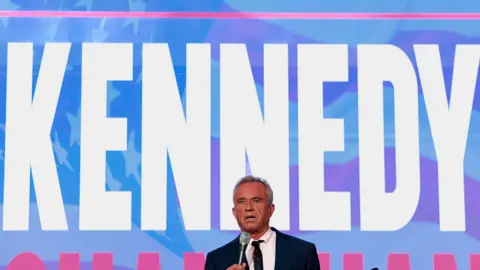ARTICLE AD BOX

 Getty Images
Getty Images
Robert F Kennedy Jr's independent White House bid was buoyed by Democratic Party chaos and dissatisfaction with two familiar candidates. But bizarre headlines, a new opponent and limited cash have left him struggling.
The 70-year-old's recent confession about dumping a dead bear in Central Park is just the latest strange twist to a campaign that was already sagging in the polls.
Mr Kennedy seems determined to test the proposition that there’s no such thing as bad publicity.
In a move to get ahead of a lengthy profile published on Monday in the New Yorker magazine, he released a video where he discusses an accident involving a bear cub a decade ago – and the unlikely series of events that followed.
In the video, Mr Kennedy is speaking to actress and comedian Roseanne Barr over a half-eaten meal of takeaway beef ribs. He describes how he watched a nearby car hit and kill a bear cub while on a day trip hunting with a falcon.
He said he initially wanted to take the dead animal home and skin it. After his schedule changed, he decided to discard the carcass in New York City’s Central Park – along with an old bicycle, in an effort to make it look like a cycling accident.
When someone discovered the bear and the bicycle the next day, it became a headline story in the New York City tabloids and television news programmes.
RFK Jr recounts bear carcass story to Roseanne Barr
Needless to say, the entire episode - which sounds like a youthful practical joke gone wrong, but took place when the candidate was 60 - is odd.
The falconry trip. The photograph, published in the New Yorker, of RFK Jr posing with the dead bear. The planned skinning and eating. The animal's final resting place in New York’s famous urban park. Even the video itself with Ms Barr – who has herself been embroiled in more than a few controversies – holding a teacup and nodding along as Mr Kennedy recounted his tale.
His explanation, that the decision to pick up the dead bear was his “little bit of redneck” coming out, doesn’t quite fit for the nephew of former President John F Kennedy – a member of an American political dynasty.
All this is standard fare for Mr Kennedy, however, whose top news lines during his campaign have veered from scandalous to plain bizarre.
In May, the New York Times ran an article revealing he had told lawyers involved in his 2012 divorce proceedings that he was suffering from a memory issue relating to a dead brain parasite.
In mid-July, Mr Kennedy texted an apology to a former family nanny after Vanity Fair magazine published a story in which she accused him of unwelcome sexual advances.
“I have no memory of this incident but I apologise sincerely for anything I ever did that made you feel uncomfortable,” he wrote.
In comments to the media, he said the Vanity Fair article contained a lot of “garbage” but conceded that he had a “very, very rambunctious youth” and that he was “not a church boy”.
There was a point earlier this year when Mr Kennedy – who launched his independent presidential bid after initially running for the Democratic nomination – was averaging around 15% in presidential preference polls. He narrowly missed qualifying for the first presidential debate in late June.
Mr Kennedy appeared to be capitalising on voter dissatisfaction with both Donald Trump and Joe Biden. His pitch blended anti-establishment and anti-corporate rhetoric with liberal social positions and a heavy dose of environmentalism and controversial vaccine scepticism.
With Mr Biden’s dismal performance during that first debate, the door may have opened for Mr Kennedy to elbow his way into the American political conversation.
Instead, he virtually disappeared off the presidential campaign trial.
He has spent little on advertising and grassroots organising. His biggest headlines involved the aforementioned brain worms, sex-harassment allegations and bear-cub escapades.
Meanwhile, his polling support has dropped to the low single digits.
According to Clifford Young, president of Ipsos public affairs, Mr Kennedy’s decline was inevitable, even without all distracting headlines.
“He was a protest option,” he said. “There was a lot of indifference when it came to the two candidates. People didn’t like either choice and it was an expression of indifference or disdain.”
Now, he says, Democrats and Republicans have consolidated their political support.


More on US election
Mr Kennedy was in Milwaukee, Wisconsin, during the Republican National Convention in late July, where he had a telephone conversation with the former president.
According to media reports, Mr Kennedy offered to endorse the former president in exchange for a role in his next administration – an offer Trump declined.
At this point, it seems unlikely that Mr Kennedy will generate much interest when Americans head to the polls in November. Even a modest performance could tip the presidential race, however, if that support comes in one of the key battleground states where the independent candidate is on the ballot.
In 2016, Green Party candidate Jill Stein received more votes than the difference between Trump and Hillary Clinton in Pennsylvania, Wisconsin and Michigan – the three decisive states in that race. If a fraction of Green Party candidate Ralph Nader’s Florida support had gone to the Democrats, Al Gore would have won the White House in 2000.
Mr Young said Mr Kennedy’s appeal is different from those two notable Green Party candidates, however. He is pulling mostly from the disaffected centre of American politics – low propensity voters who tilt slightly to the right.
The Green Party candidates, on the other hand, were damaging the Democrats by pulling almost exclusively from the left.
Mr Kennedy could still play the spoiler, but it would have to be another extremely close race. And, in the meantime, his chance to shape his campaign’s direction on a larger scale seem to have been buried under an avalanche of strangeness.

 3 months ago
33
3 months ago
33








 English (US)
English (US)